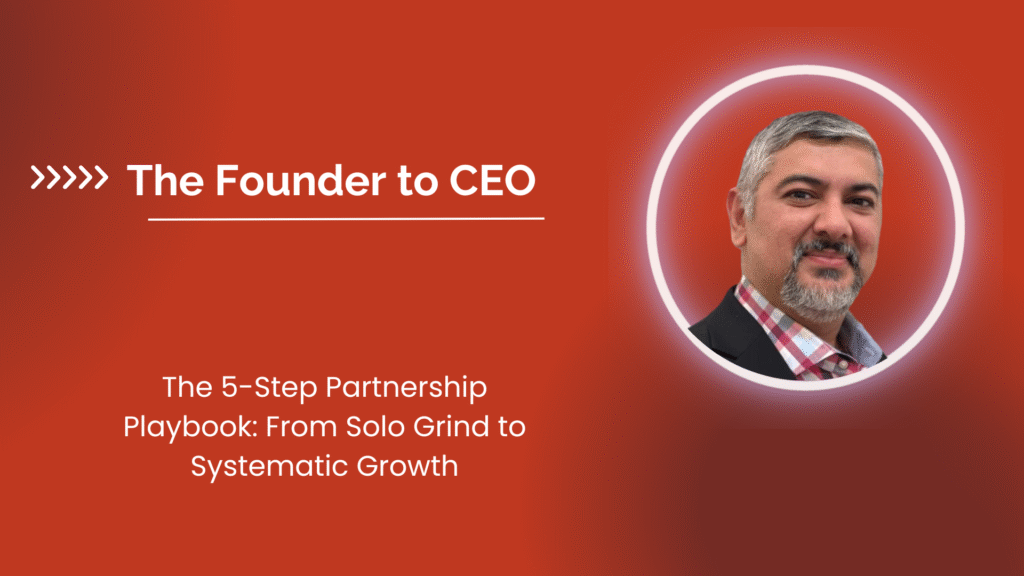Your competitor just landed a distribution deal that puts their product in front of 5,000 potential customers. Meanwhile, you’re still cold-emailing prospects one by one, wondering why growth feels like pushing a boulder uphill.
No business is an island. Solo founders stay small.
Partnership builders scale fast. Growth comes faster, smarter, and stronger when you build alliances that extend your reach and multiply your impact.
The difference isn’t talent or product quality. It’s leverage. While you’re grinding in isolation, smart founders are building alliances that multiply their reach, credibility, and impact. They understand the ecosystem is the ultimate growth engine.
Stop trying to be a one-person army. Start building your coalition.
Here’s your step-by-step guide to building partnerships that pay off.
Step 1: Identify Your Missing Pieces
Think of your business like a puzzle. You’ve got a few cornerstone pieces, but there are gaps that prevent the picture from coming together.
- For SaaS, maybe you’re great at product but weak at distribution.
- For ecommerce, maybe you’ve nailed sourcing but lack marketing firepower.
Instead of forcing yourself to cover every gap alone, ask: Who already owns the missing piece, and how can I link arms with them?
Action step: Write down three areas where your business consistently struggles. Next to each, list potential companies or individuals already strong in that domain. That’s your first hit list for potential partnerships.
Step 2: Build Bridges, Not Transactions
Too many founders approach partnerships like they’re networking at a conference where everyone’s trying to collect business cards and make quick pitches.
That transactional energy repels the very people you want to attract.
The partnerships that actually pay off feel less like a sales pitch and more like a bridge, built on shared values, aligned customers, and long-term thinking.
Example: A SaaS analytics platform partners with an ecommerce agency. The SaaS gets distribution to sellers; the agency gets to look smarter with better data. Both win.
Remember: Don’t lead with your needs. Start by genuinely understanding how you can make your potential partner the hero in their customers’ success stories. That’s the cement that keeps bridges from collapsing.
Step 3: Create Value Multipliers
A strategic partnership isn’t just two businesses working side by side; it’s mathematical magic where one plus one equals five.
- Co-marketing campaigns that double your audience reach.
- Joint product bundles that make buyers feel they’re getting more for less.
- Integrations that remove friction and increase adoption.
Think of Amazon’s “Frequently Bought Together” feature. That’s partnership thinking baked into a product.
Watch how top entrepreneurs partner across industries. The wellness coach teams with the productivity app founder. The sustainable fashion brand collaborates with the mindful parenting expert. Each partnership creates new conversations, new audiences, new possibilities.
Action step: When evaluating any partnership opportunity, ask yourself: “Does this collaboration create exponentially more value than we could generate independently?” If it’s just additive, keep refining the concept.
Step 4: Negotiate for Alignment, Not Just Terms
This is where many founders blow it. They treat partnership negotiations like squeezing pennies out of a vendor contract.
But partnerships aren’t just about terms. They’re about alignment.
- Customer overlap: Do we serve the same type of person in different ways?
- Values match: Do we operate with similar principles and standards?
- Timeline sync: Are our growth phases and priorities compatible?
- Commitment level: Is both sides willing to invest real resources?
A great deal on paper means nothing if the execution collapses due to misaligned priorities.
Before signing anything, examine the four questions above. If any of these are misaligned, walk away. A bad partnership is worse than no partnership.
Step 5: Systemize and Scale
Once you’ve cracked the code with one partner, don’t stop. Partnerships compound.
But here’s the trap: Many founders treat partnerships as one-off experiments instead of systems.
The real winners create a repeatable process:
- Define the ideal partner profile.
- Create a playbook for outreach and onboarding.
- Track results just like you would a marketing channel.
For SaaS, this might look like a partner ecosystem program with tiered benefits. For ecommerce, it could be an affiliate network or brand alliance group.
Action step: Write down the “recipe” you used to land your best partnership. That’s the blueprint to scale with the next five.
Final Reflection
Right now, you have two choices.
Keep grinding alone, hoping your individual effort will eventually break through.
Or start building the alliances that will amplify everything you’re already doing well.
Going solo may feel heroic, but it’s rarely how great companies scale. The ecosystem is where real leverage lives.
Ask yourself: Am I playing the lone wolf, or am I building the pack?
The partnerships you craft today could be the very thing that turns your steady grind into explosive growth.
So stop trying to be an island. Start building bridges. The compounding effect will pay off in ways you can’t achieve alone.
Final question: What partnership conversation have you been avoiding that could change your business trajectory?
Time to make that call.


